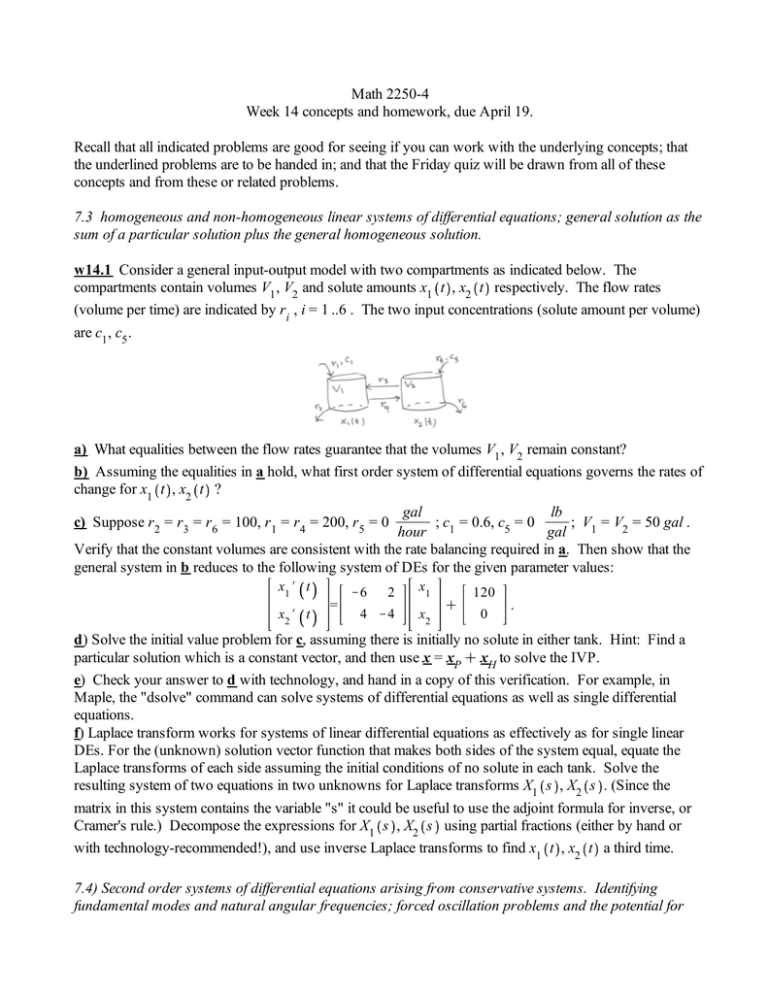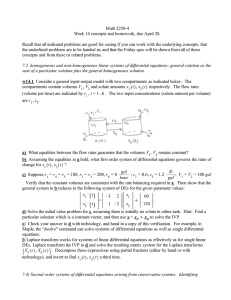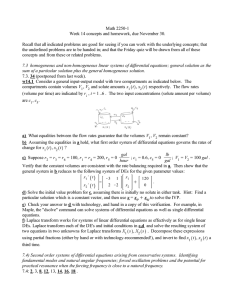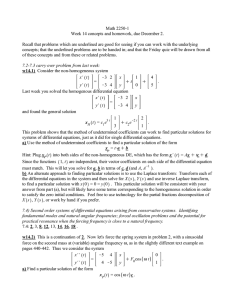Math 2250-4 Week 14 concepts and homework, due April 19.
advertisement

Math 2250-4 Week 14 concepts and homework, due April 19. Recall that all indicated problems are good for seeing if you can work with the underlying concepts; that the underlined problems are to be handed in; and that the Friday quiz will be drawn from all of these concepts and from these or related problems. 7.3 homogeneous and non-homogeneous linear systems of differential equations; general solution as the sum of a particular solution plus the general homogeneous solution. w14.1 Consider a general input-output model with two compartments as indicated below. The compartments contain volumes V1 , V2 and solute amounts x1 t , x2 t respectively. The flow rates (volume per time) are indicated by ri , i = 1 ..6 . The two input concentrations (solute amount per volume) are c1 , c5 . a) What equalities between the flow rates guarantee that the volumes V1 , V2 remain constant? b) Assuming the equalities in a hold, what first order system of differential equations governs the rates of change for x1 t , x2 t ? gal lb c) Suppose r2 = r3 = r6 = 100, r1 = r4 = 200, r5 = 0 ; c1 = 0.6, c5 = 0 ; V1 = V2 = 50 gal . hour gal Verify that the constant volumes are consistent with the rate balancing required in a. Then show that the general system in b reduces to the following system of DEs for the given parameter values: x1 # t x2 # t = 2 x1 4 K4 x2 K6 C 120 0 . d) Solve the initial value problem for c, assuming there is initially no solute in either tank. Hint: Find a particular solution which is a constant vector, and then use x = xP C xH to solve the IVP. e) Check your answer to d with technology, and hand in a copy of this verification. For example, in Maple, the "dsolve" command can solve systems of differential equations as well as single differential equations. f) Laplace transform works for systems of linear differential equations as effectively as for single linear DEs. For the (unknown) solution vector function that makes both sides of the system equal, equate the Laplace transforms of each side assuming the initial conditions of no solute in each tank. Solve the resulting system of two equations in two unknowns for Laplace transforms X1 s , X2 s . (Since the matrix in this system contains the variable "s" it could be useful to use the adjoint formula for inverse, or Cramer's rule.) Decompose the expressions for X1 s , X2 s using partial fractions (either by hand or with technology-recommended!), and use inverse Laplace transforms to find x1 t , x2 t a third time. 7.4) Second order systems of differential equations arising from conservative systems. Identifying fundamental modes and natural angular frequencies; forced oscillation problems and the potential for practical resonance when the forcing frequency is close to a natural frequency. 7.4: 2, 3, 8, 12, 13, 14, 16, 18 . w14.2) This is a continuation of 2. Now let's force the spring system in problem 2, with a sinusoidal force on the first mass at (variable) angular frequency w, as in the slightly different text example on pages 440-442. Thus we consider the system x## t K5 4 x 1 = C F0 cos w t . y## t 4 K5 y 0 a) Find a particular solution of the form xP t = cos w t c . Hint: Plug this guess into the differential equation. You will notice that each term simplifies to some vector times the function cos w t . Thus, after you factor out the cos w t term you are left with a matrix equation to solve for c = c w . You will get formulas analogous to equations (34, 35) on page 441, except your c1 , c2 will blow up at w = 1, 3 , the natural frequencies for this problem. b) The general solution to this forced oscillation problem is the particular solution from part (a), plus the general solution to the homogeneous problem, which you found in problem (2). In a physical problem with a slight amount of damping but the same masses and spring constants, the particular solution would be close to the one you found in part (a), and the homogeneous solutions would be close to the ones you found in problem 2, except that they would be (slowly) exponentially decaying because of the damping. Thus the particular solution would be the steady periodic solution, and the homogeneous solution would 2 2 be transient. By plotting the magnitude c w = c1 w C c2 w as a function of w, you create a "practical resonance" chart analogous to those we created in Chapter 5. Create such a plot, for the angular frequency range 0 % w % 5. Use F0 = 4 . Your plot should look like Figure 7.4.10, except your magnitude function will peak at w = 1, 3 . w14.3) This is a continuation of 12. As we discuss in class on Friday April 12, if a matrix is multiplied by a scalar c , then the eigevectors of the new matrix are the same as the eigenvectors of the original matrix, but the corresponding eigenvalues are all multiplied by c . (This is the simple fact that if A v = lv then ( cA v = c l v .) a) Suppose the same configuration as in 12 in which all the spring constants are equal and all the masses are equal, except that now the numerical values are related by k = 9 m rather than k = m (so the springs are stiffer relative to the mass). How are the new natural frequencies related to what they were in problem 12? How about the natural modes? b) What if it was the reverse situation, i.e. heavy masses relative to the spring constants, so that e.g. m=5k? w14.4) This is a continuation of 18. In physics you learn that you can recover the final velocities from the initial ones in a conservative problem like 18 by equating the initial momentum m1 v0 to the final 1 momentum m1 v1 C m2 v2 and the initial kinetic energy m1 v20 to the final kinetic energy 2 1 1 m v2 C m2 v22 , and solving this system of equations for v1 and v2 . Carry this procedure out for the 2 1 1 2 data in 18 and show that your answer agrees with your work in that problem.




